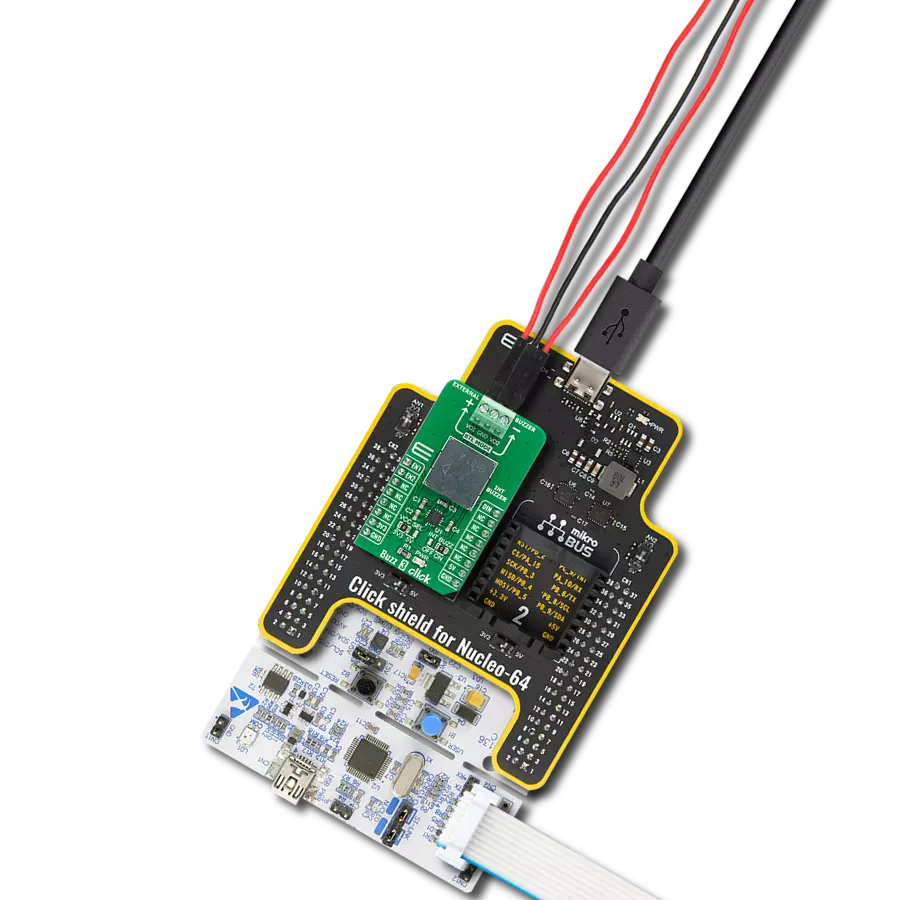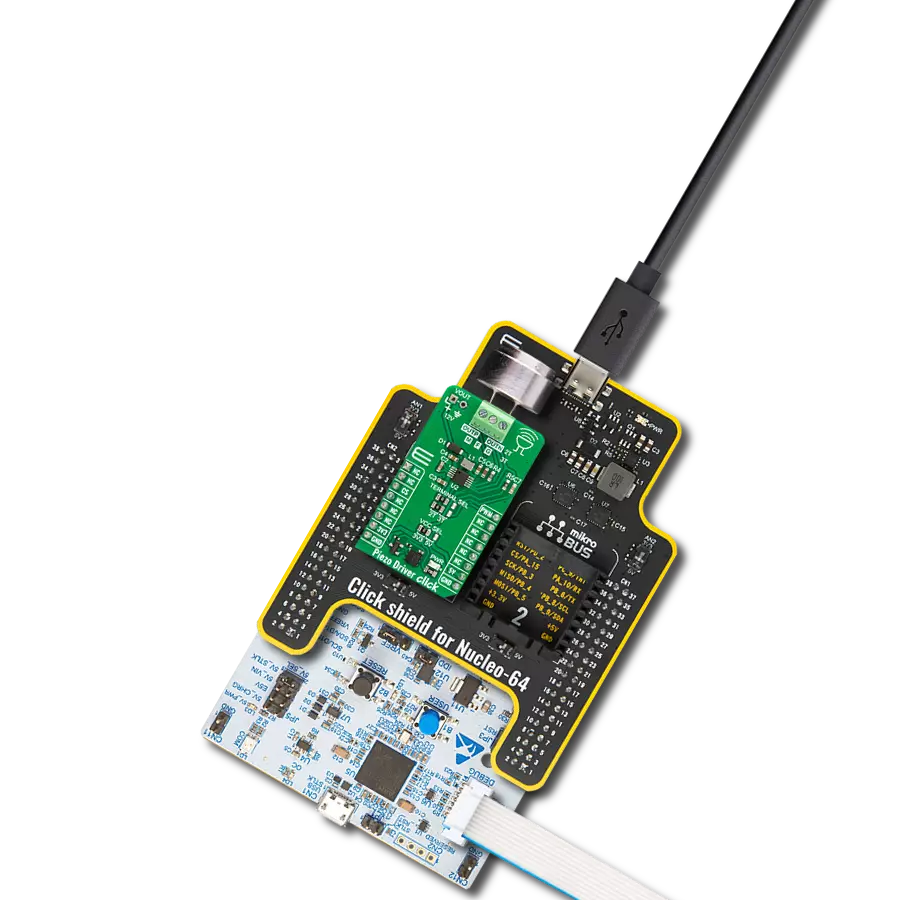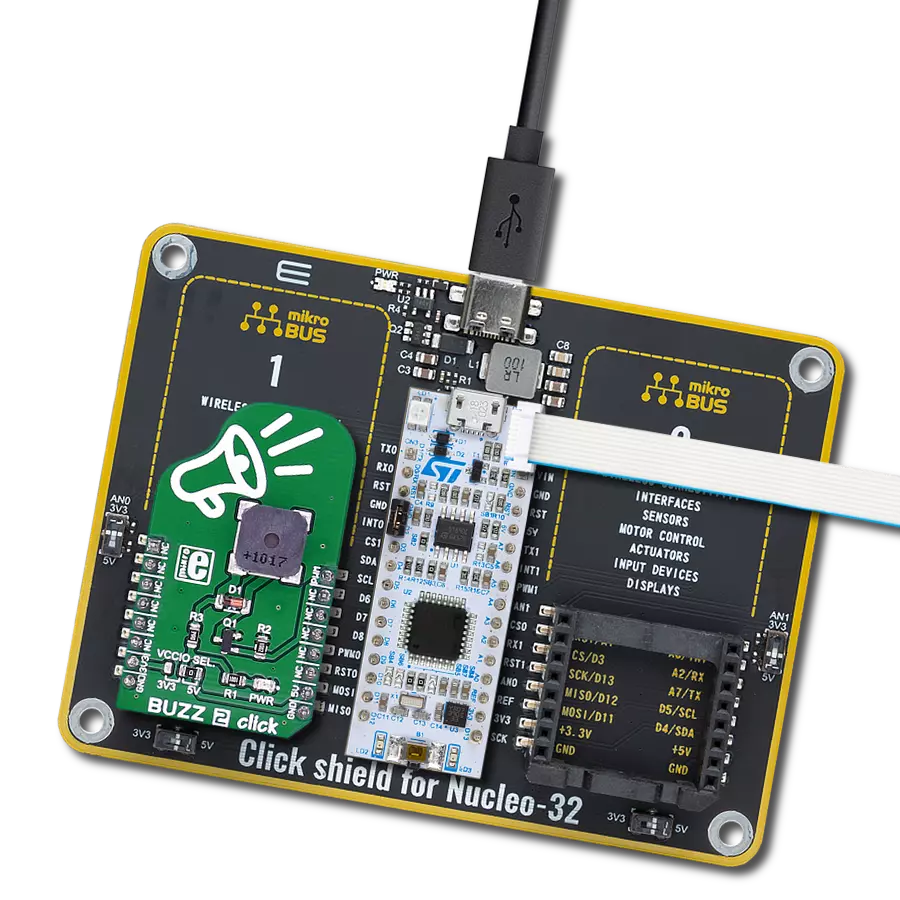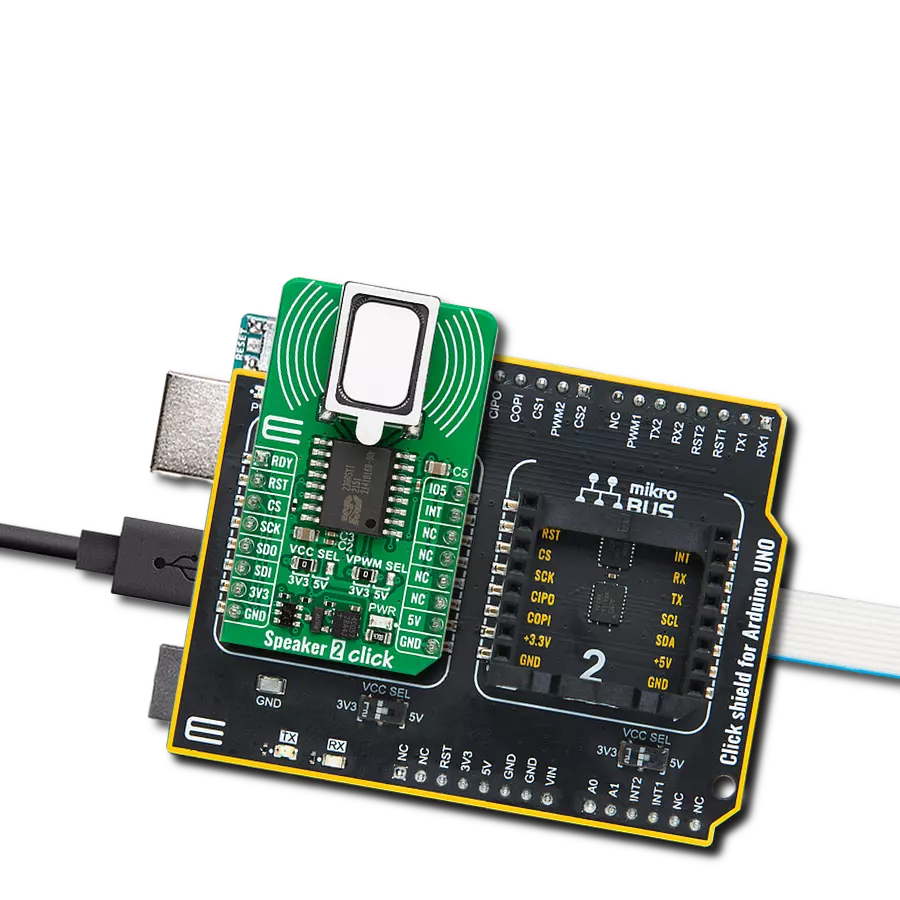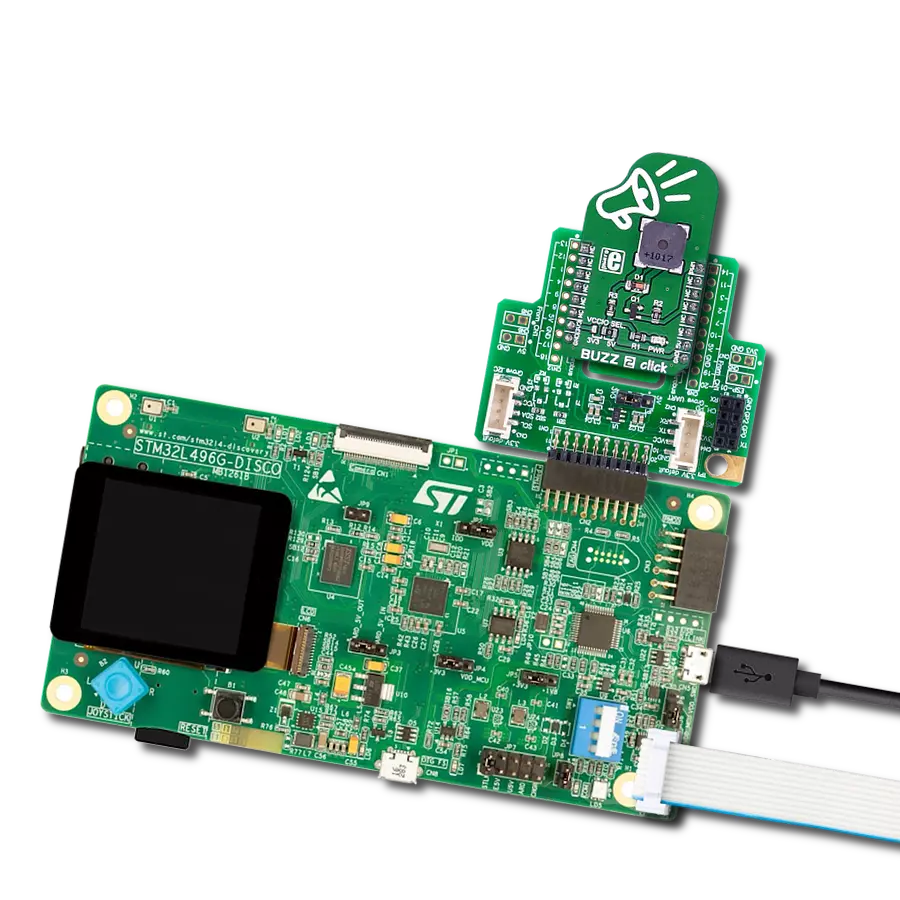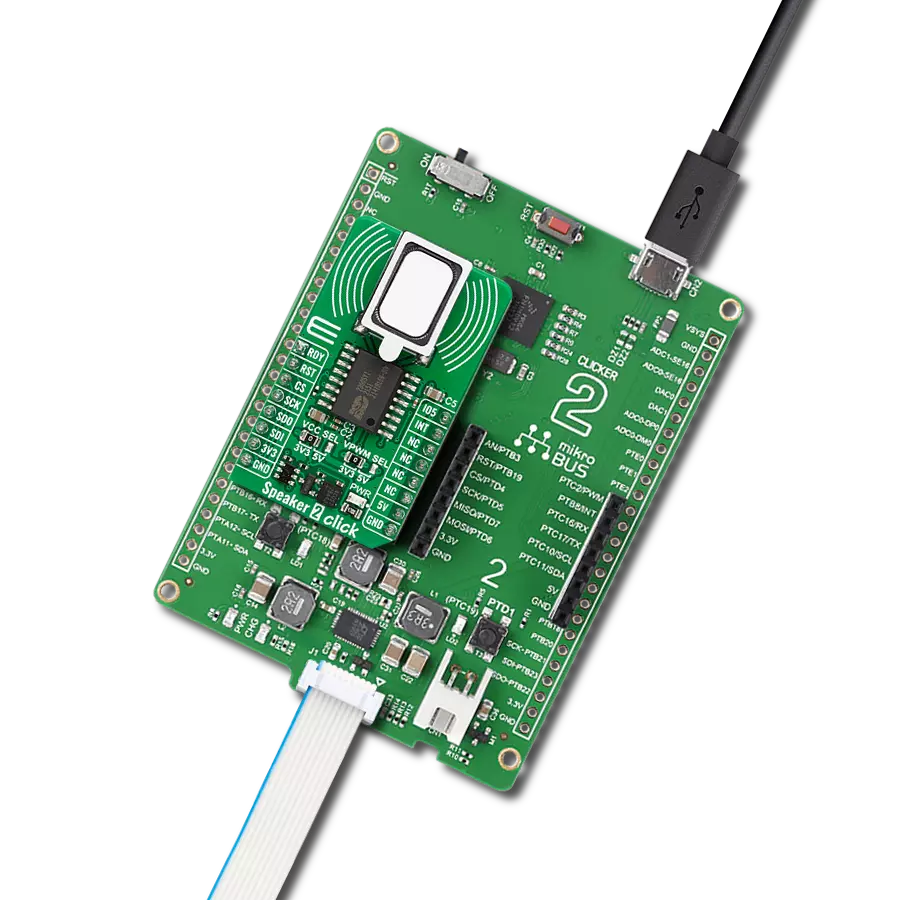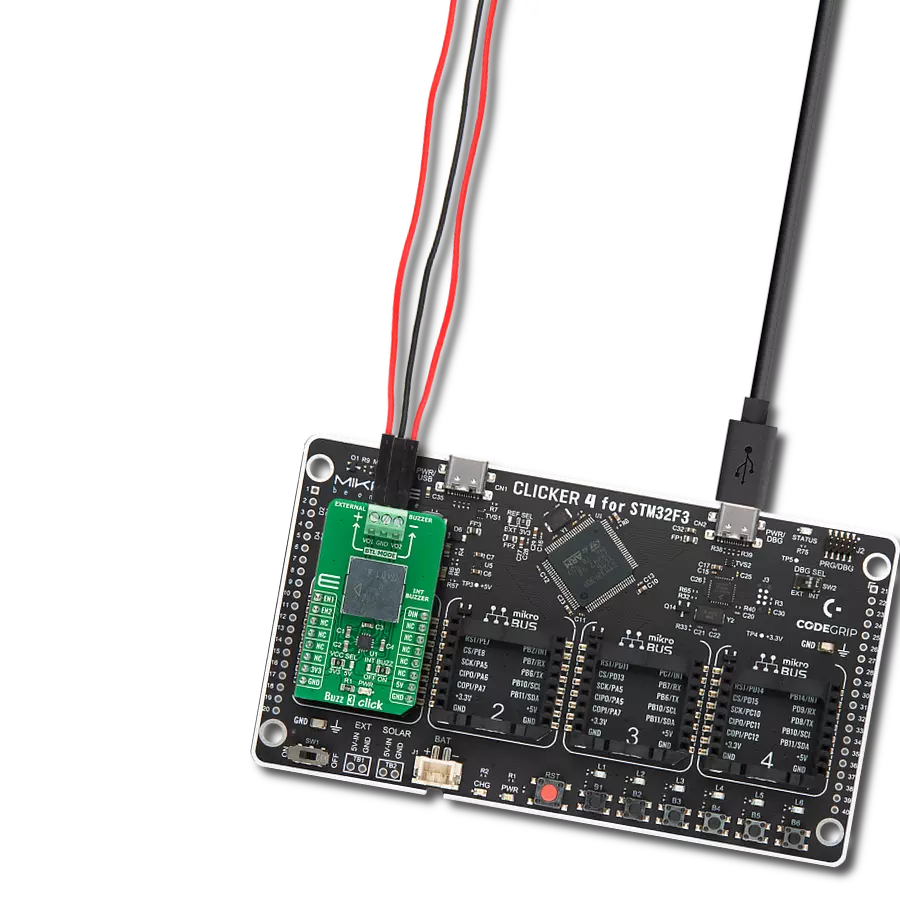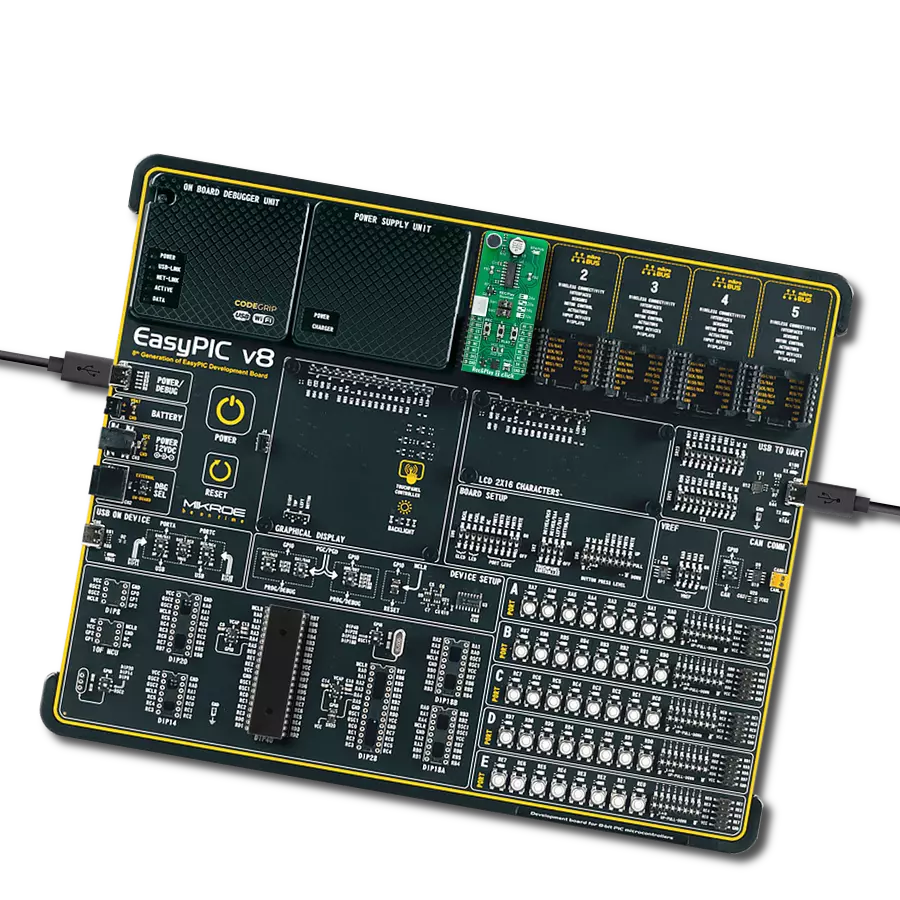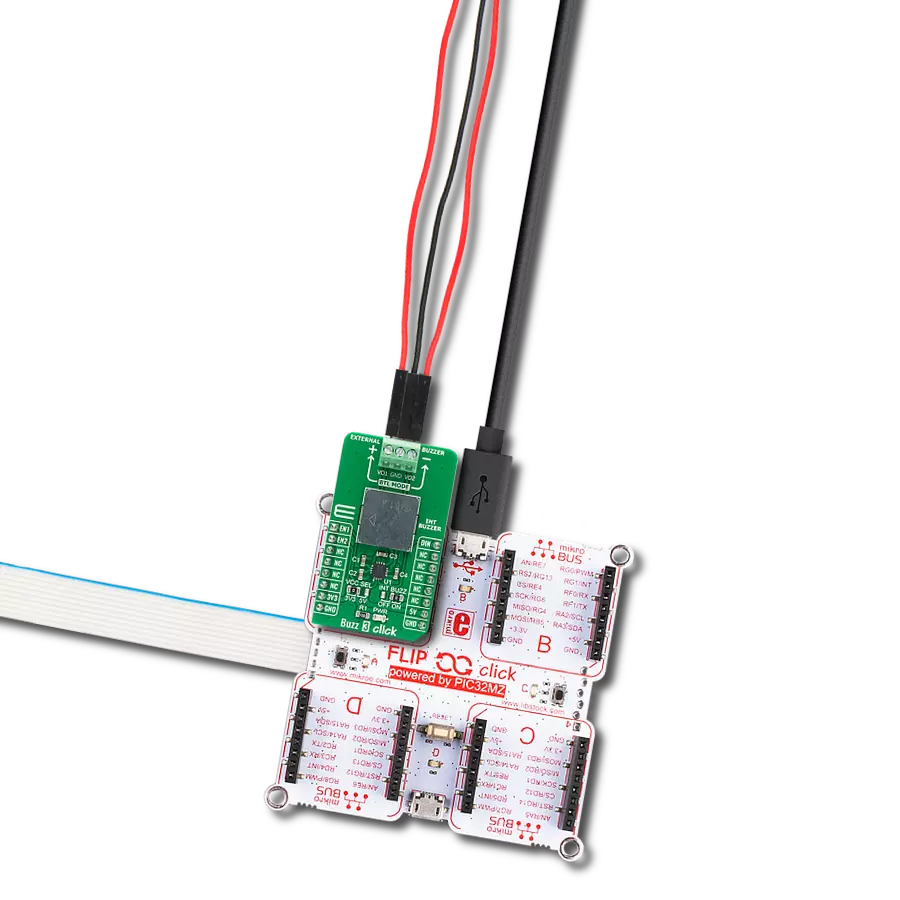踏入音频信号的未来,体验新一代蜂鸣器在各行各业和各种环境中的变革性影响。
A
A
硬件概览
它是如何工作的?
Buzz 3 Click 基于Diodes Incorporated的PAM8904,这是一款带集成多模式电荷泵升压转换器的压电发声器驱动器。PAM8904是一种开关驱动器,具有多模式电荷泵,用于压电发声器。PAM8904以固定频率1MHz工作,可以驱动高达15nF的发声器负载,提供9V输出,并具有最小的组件占用空间。为了调整压电发声器的音量,电荷泵可以在1x、2x或3x模式下工作。它具有热关断、过流和过压保护、欠压锁定等功能,提供小的浪涌电流、低EMI和高效率。发声器驱动器通过采用内置自动关断和唤醒功能,有助于保持低电流消耗和延长电池寿命。例如,在1x模式下,输入电压为3V、输入
频率为4kHz、驱动15nF压电发声器时,活动电流消耗仅为300µA。在关断模式下,静态电流小于1µA。电荷泵模式引脚EN1和EN2用于将电荷泵设置为1xVDD、2xVDD、3xVDD模式,或者用于将PAM8904置于强制低电流关断模式。当一个或两个EN引脚被拉高时,设备进入正常操作模式。一旦PAM8904检测到DIN引脚上有有效信号,电荷泵将启动并在VOUT引脚上提供所需电压,标记为VO1和VO2的输出驱动线将在270μs至350μs之间的时间内变为活动状态,具体取决于所选模式。如果DIN线上的有效信号消失,PAM8904将检测到该消失,然后等待42ms以确保其消失。如果即使在此期间
后,DIN线上仍没有有效信号,PAM8904将切换到低电流待机模式。Buzz 3 Click通过连接到mikroBUS™插座的RST、AN和PWM引脚(标记为EN1、EN2和DIN)的多个GPIO引脚与MCU建立通信。此外,还有一个标记为INT BUZZ的跳线设置,用于在单端和差分负载配置之间选择,以及驱动板载压电发声器或外部连接的压电发声器。此Click板™可以通过VCC SEL跳线选择3.3V或5V逻辑电压等级。这样,3.3V和5V能力的MCU都可以正确使用通信线。此外,该Click板™配备了一个包含易于使用功能和示例代码的库,可用作进一步开发的参考。
功能概述
开发板
Nucleo-64搭载STM32L073RZ MCU提供了一个经济实惠且灵活的平台,供开发人员探索新的想法并原型化其设计。该板利用了STM32微控制器的多功能性,使用户能够为其项目选择性能和功耗之间的最佳平衡。它采用LQFP64封装的STM32微控制器,并包括一些必要的组件,例如用户LED,可以同时作为ARDUINO®信号使用,以及用户和复位按钮,以及用于精准定时操作的32.768kHz晶体振荡器。设计时考虑了扩展性和灵活性,Nucleo-64板具有ARDUINO®
Uno V3扩展连接器和ST morpho扩展引脚标头,为全面项目集成提供了对STM32 I/O的完全访问权限。电源选项具有适应性,支持ST-LINK USB VBUS或外部电源,确保在各种开发环境中的适应性。该板还配备了一个内置的ST-LINK调试器/编程器,具有USB重新枚举功能,简化了编程和调试过程。此外,该板还设计了外部SMPS,以实现有效的Vcore逻辑供电,支持USB设备全速或USB SNK/UFP全速,以及内置的加密功能,增强了项目的功耗效率和安全性。通过专用
连接器提供了额外的连接性,用于外部SMPS实验、ST-LINK的USB连接器和MIPI®调试连接器,扩展了硬件接口和实验的可能性。开发人员将通过STM32Cube MCU软件包中全面的免费软件库和示例得到广泛的支持。这与与各种集成开发环境(IDE)的兼容性相结合,包括IAR Embedded Workbench®、MDK-ARM和STM32CubeIDE,确保了平稳高效的开发体验,使用户能够充分发挥Nucleo-64板在其项目中的功能。
微控制器概述
MCU卡片 / MCU
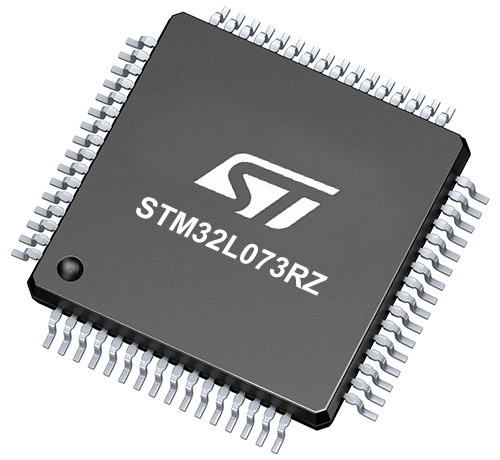
建筑
ARM Cortex-M0
MCU 内存 (KB)
192
硅供应商
STMicroelectronics
引脚数
64
RAM (字节)
20480
你完善了我!
配件
Click Shield for Nucleo-64 配备了两个专有的 mikroBUS™ 插座,使得所有的 Click board™ 设备都可以轻松地与 STM32 Nucleo-64 开发板连接。这样,Mikroe 允许其用户从不断增长的 Click boards™ 范围中添加任何功能,如 WiFi、GSM、GPS、蓝牙、ZigBee、环境传感器、LED、语音识别、电机控制、运动传感器等。您可以使用超过 1537 个 Click boards™,这些 Click boards™ 可以堆叠和集成。STM32 Nucleo-64 开发板基于 64 引脚封装的微控制器,采用 32 位 MCU,配备 ARM Cortex M4 处理器,运行速度为 84MHz,具有 512Kb Flash 和 96KB SRAM,分为两个区域,顶部区域代表 ST-Link/V2 调试器和编程器,而底部区域是一个实际的开发板。通过 USB 连接方便地控制和供电这些板子,以便直接对 Nucleo-64 开发板进行编程和高效调试,其中还需要额外的 USB 线连接到板子上的 USB 迷你接口。大多数 STM32 微控制器引脚都连接到了板子左右边缘的 IO 引脚上,然后连接到两个现有的 mikroBUS™ 插座上。该 Click Shield 还有几个开关,用于选择 mikroBUS™ 插座上模拟信号的逻辑电平和 mikroBUS™ 插座本身的逻辑电压电平。此外,用户还可以通过现有的双向电平转换器,使用任何 Click board™,无论 Click board™ 是否在 3.3V 或 5V 逻辑电压电平下运行。一旦将 STM32 Nucleo-64 开发板与我们的 Click Shield for Nucleo-64 连接,您就可以访问数百个工作于 3.3V 或 5V 逻辑电压电平的 Click boards™。
使用的MCU引脚
mikroBUS™映射器
“仔细看看!”
Click board™ 原理图

一步一步来
项目组装
软件支持
库描述
该库包含 Buzz 3 Click 驱动程序的 API。
关键功能:
buzz3_pwm_start- 此功能启动PWM模块输出buzz3_set_gain_operating_mode- 此功能设置Buzz 3 Click上带有集成升压转换器的PAM8904压电发声器驱动器的增益操作模式buzz3_play_sound- 此功能在蜂鸣器上播放声音
开源
代码示例
完整的应用程序代码和一个现成的项目可以通过NECTO Studio包管理器直接安装到NECTO Studio。 应用程序代码也可以在MIKROE的GitHub账户中找到。
/*!
* @file main.c
* @brief Buzz3 Click example
*
* # Description
* This example demonstrates the use of Buzz 3 Click boards with PAM8904 for play the Imperial March.
* PAM8904 is piezo-sounder driver with an integrated Multi-Mode charge pump boost converter from Diodes Incorporated.
*
* The demo application is composed of two sections :
*
* ## Application Init
* Initializes GPIO, set AN and RST pin as outputs, begins to write a log.
* Initialization driver enables - GPIO and configures the appropriate MCU pin for
* sound generation, also write log.
*
* ## Application Task
* Plays the Imperial March melody. Also logs an appropriate message on the USB UART.
*
* Additional Functions :
* - void buzz3_melody( void ) - This function plays the Imperial March melody.
*
* @note
* The minimal PWM Clock frequency required for this example is the frequency of tone C6 - 1047 Hz.
* So, in order to run this example and play all tones correctly, the user will need to decrease
* the MCU's main clock frequency in MCU Settings for the certain architectures
* in order to get the required PWM clock frequency.
*
* @author Jelena Milosavljevic
*
*/
#include "board.h"
#include "log.h"
#include "buzz3.h"
#define W 4*Q // Whole 4/4 - 4 Beats
#define H 2*Q // Half 2/4 - 2 Beats
#define Q 250 // Quarter 1/4 - 1 Beat
#define E Q/2 // Eighth 1/8 - 1/2 Beat
#define S Q/4 // Sixteenth 1/16 - 1/4 Beat
static buzz3_t buzz3;
static log_t logger;
void buzz3_melody ( void ) {
buzz3_play_sound(&buzz3, BUZZ3_NOTE_A6, Q );
Delay_ms ( 1 + Q );
buzz3_play_sound(&buzz3, BUZZ3_NOTE_A6, Q );
Delay_ms ( 1 + Q );
buzz3_play_sound(&buzz3, BUZZ3_NOTE_A6, Q );
Delay_ms ( 1 + Q );
buzz3_play_sound(&buzz3, BUZZ3_NOTE_F6, E + S );
Delay_ms ( 1 + E + S );
buzz3_play_sound(&buzz3, BUZZ3_NOTE_C7, S );
Delay_ms ( 1 + S );
buzz3_play_sound(&buzz3, BUZZ3_NOTE_A6, Q );
Delay_ms ( 1 + Q );
buzz3_play_sound(&buzz3, BUZZ3_NOTE_F6, E + S );
Delay_ms ( 1 + E + S );
buzz3_play_sound(&buzz3, BUZZ3_NOTE_C7, S );
Delay_ms ( 1 + S );
buzz3_play_sound(&buzz3, BUZZ3_NOTE_A6, H );
Delay_ms ( 1 + H );
buzz3_play_sound(&buzz3, BUZZ3_NOTE_E7, Q );
Delay_ms ( 1 + Q );
buzz3_play_sound(&buzz3, BUZZ3_NOTE_E7, Q );
Delay_ms ( 1 + Q );
buzz3_play_sound(&buzz3, BUZZ3_NOTE_E7, Q );
Delay_ms ( 1 + Q );
buzz3_play_sound(&buzz3, BUZZ3_NOTE_F7, E + S );
Delay_ms ( 1 + E + S );
buzz3_play_sound(&buzz3, BUZZ3_NOTE_C7, S );
Delay_ms ( 1 + S );
buzz3_play_sound(&buzz3, BUZZ3_NOTE_Ab6, Q );
Delay_ms ( 1 + Q );
buzz3_play_sound(&buzz3, BUZZ3_NOTE_F6, E + S );
Delay_ms ( 1 + E + S );
buzz3_play_sound(&buzz3, BUZZ3_NOTE_C7, S );
Delay_ms ( 1 + S );
buzz3_play_sound(&buzz3, BUZZ3_NOTE_A6, H );
Delay_ms ( 1 + H );
buzz3_play_sound(&buzz3, BUZZ3_NOTE_A7, Q );
Delay_ms ( 1 + Q );
buzz3_play_sound(&buzz3, BUZZ3_NOTE_A6, E + S );
Delay_ms ( 1 + E + S );
buzz3_play_sound(&buzz3, BUZZ3_NOTE_A6, S );
Delay_ms ( 1 + S );
buzz3_play_sound(&buzz3, BUZZ3_NOTE_A7, Q );
Delay_ms ( 1 + Q );
buzz3_play_sound(&buzz3, BUZZ3_NOTE_Ab7, E + S );
Delay_ms ( 1 + E + S );
buzz3_play_sound(&buzz3, BUZZ3_NOTE_G7, S );
Delay_ms ( 1 + S );
buzz3_play_sound(&buzz3, BUZZ3_NOTE_Gb7, S );
Delay_ms ( 1 + S );
buzz3_play_sound(&buzz3, BUZZ3_NOTE_E7, Q );
Delay_ms ( 1 + Q );
buzz3_play_sound(&buzz3, BUZZ3_NOTE_F7, E );
Delay_ms ( 1 + E );
Delay_ms ( 1 + E );
buzz3_play_sound(&buzz3, BUZZ3_NOTE_Bb6, E );
Delay_ms ( 1 + E );
buzz3_play_sound(&buzz3, BUZZ3_NOTE_Eb7, Q );
Delay_ms ( 1 + Q );
buzz3_play_sound(&buzz3, BUZZ3_NOTE_D7, E + S );
Delay_ms ( 1 + E + S );
buzz3_play_sound(&buzz3, BUZZ3_NOTE_Db7, S );
Delay_ms ( 1 + S );
buzz3_play_sound(&buzz3, BUZZ3_NOTE_C7, S );
Delay_ms ( 1 + S );
buzz3_play_sound(&buzz3, BUZZ3_NOTE_B6, S );
Delay_ms ( 1 + S );
buzz3_play_sound(&buzz3, BUZZ3_NOTE_C7, E );
Delay_ms ( 1 + E );
Delay_ms ( 1 + E );
buzz3_play_sound(&buzz3, BUZZ3_NOTE_F6, E );
Delay_ms ( 1 + E );
buzz3_play_sound(&buzz3, BUZZ3_NOTE_Ab6, Q );
Delay_ms ( 1 + Q );
buzz3_play_sound(&buzz3, BUZZ3_NOTE_F6, E + S );
Delay_ms ( 1 + E + S );
buzz3_play_sound(&buzz3, BUZZ3_NOTE_A6, S );
Delay_ms ( 1 + S );
buzz3_play_sound(&buzz3, BUZZ3_NOTE_C7, Q );
Delay_ms ( 1 + Q );
buzz3_play_sound(&buzz3, BUZZ3_NOTE_A6, E + S );
Delay_ms ( 1 + E + S );
buzz3_play_sound(&buzz3, BUZZ3_NOTE_C7, S );
Delay_ms ( 1 + S );
buzz3_play_sound(&buzz3, BUZZ3_NOTE_E7, H );
Delay_ms ( 1 + H );
buzz3_play_sound(&buzz3, BUZZ3_NOTE_A7, Q );
Delay_ms ( 1 + Q );
buzz3_play_sound(&buzz3, BUZZ3_NOTE_A6, E + S );
Delay_ms ( 1 + E + S );
buzz3_play_sound(&buzz3, BUZZ3_NOTE_A6, S );
Delay_ms ( 1 + S );
buzz3_play_sound(&buzz3, BUZZ3_NOTE_A7, Q );
Delay_ms ( 1 + Q );
buzz3_play_sound(&buzz3, BUZZ3_NOTE_Ab7, E + S );
Delay_ms ( 1 + E + S );
buzz3_play_sound(&buzz3, BUZZ3_NOTE_G7, S );
Delay_ms ( 1 + S );
buzz3_play_sound(&buzz3, BUZZ3_NOTE_Gb7, S );
Delay_ms ( 1 + S );
buzz3_play_sound(&buzz3, BUZZ3_NOTE_E7, S );
Delay_ms ( 1 + S );
buzz3_play_sound(&buzz3, BUZZ3_NOTE_F7, E );
Delay_ms ( 1 + E );
Delay_ms ( 1 + E );
buzz3_play_sound(&buzz3, BUZZ3_NOTE_Bb6, E );
Delay_ms ( 1 + E );
buzz3_play_sound(&buzz3, BUZZ3_NOTE_Eb7, Q );
Delay_ms ( 1 + Q );
buzz3_play_sound(&buzz3, BUZZ3_NOTE_D7, E + S );
Delay_ms ( 1 + E + S );
buzz3_play_sound(&buzz3, BUZZ3_NOTE_Db7, S );
Delay_ms ( 1 + S );
buzz3_play_sound(&buzz3, BUZZ3_NOTE_C7, S );
Delay_ms ( 1 + S );
buzz3_play_sound(&buzz3, BUZZ3_NOTE_B6, S );
Delay_ms ( 1 + S );
buzz3_play_sound(&buzz3, BUZZ3_NOTE_C7, E );
Delay_ms ( 1 + E );
Delay_ms ( 1 + E );
buzz3_play_sound(&buzz3, BUZZ3_NOTE_F6, E );
Delay_ms ( 1 + E );
buzz3_play_sound(&buzz3, BUZZ3_NOTE_Ab6, Q );
Delay_ms ( 1 + Q );
buzz3_play_sound(&buzz3, BUZZ3_NOTE_F6, E + S );
Delay_ms ( 1 + E + S );
buzz3_play_sound(&buzz3, BUZZ3_NOTE_C7, S );
Delay_ms ( 1 + S );
buzz3_play_sound(&buzz3, BUZZ3_NOTE_A6, Q );
Delay_ms ( 1 + Q );
buzz3_play_sound(&buzz3, BUZZ3_NOTE_F6, E + S );
Delay_ms ( 1 + E + S );
buzz3_play_sound(&buzz3, BUZZ3_NOTE_C7, S );
Delay_ms ( 1 + S );
buzz3_play_sound(&buzz3, BUZZ3_NOTE_Ab6, H );
Delay_ms ( 1 + H );
}
void application_init ( void )
{
log_cfg_t log_cfg; /**< Logger config object. */
buzz3_cfg_t buzz3_cfg; /**< Click config object. */
/**
* Logger initialization.
* Default baud rate: 115200
* Default log level: LOG_LEVEL_DEBUG
* @note If USB_UART_RX and USB_UART_TX
* are defined as HAL_PIN_NC, you will
* need to define them manually for log to work.
* See @b LOG_MAP_USB_UART macro definition for detailed explanation.
*/
LOG_MAP_USB_UART( log_cfg );
log_init( &logger, &log_cfg );
log_info( &logger, " Application Init " );
// Click initialization.
buzz3_cfg_setup( &buzz3_cfg );
BUZZ3_MAP_MIKROBUS( buzz3_cfg, MIKROBUS_1 );
err_t init_flag = buzz3_init( &buzz3, &buzz3_cfg );
if ( PWM_ERROR == init_flag )
{
log_error( &logger, " Application Init Error. " );
log_info( &logger, " Please, run program again... " );
for ( ; ; );
}
buzz3_default_cfg ( &buzz3 );
buzz3_set_duty_cycle ( &buzz3, 0.0 );
log_printf( &logger, "---------------------\r\n" );
log_printf( &logger, " Set the gain to x1 \r\n" );
log_printf( &logger, "---------------------\r\n" );
Delay_ms ( 100 );
buzz3_pwm_start( &buzz3 );
buzz3_set_gain_operating_mode( &buzz3, BUZZ3_OP_MODE_GAIN_x1 );
log_info( &logger, " Application Task " );
}
void application_task ( void )
{
log_printf( &logger, " Play the music \r\n" );
buzz3_melody( );
log_printf( &logger, "---------------------\r\n" );
Delay_ms ( 1000 );
}
int main ( void )
{
/* Do not remove this line or clock might not be set correctly. */
#ifdef PREINIT_SUPPORTED
preinit();
#endif
application_init( );
for ( ; ; )
{
application_task( );
}
return 0;
}
// ------------------------------------------------------------------------ END
额外支持
资源
类别:扬声器
